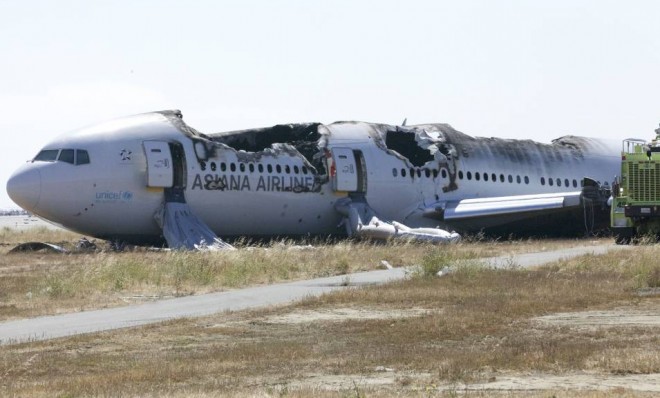Why Asiana Flight 214 crashed at San Francisco International Airport
"We were so close to the water, the water got sprayed up. There were walls of water beside the window — before we started hitting earth."


On Saturday morning, Asiana Airline Flight 214 crashed onto the runway of San Francisco International Airport with 291 passengers and a crew of 16 on board. Two of the passengers — teenage girls from China's coastal Zhejiang province on their way to a summer camp with 23 other Chinese classmates — died. More than 180 passengers were injured, including two paralyzed with spinal injuries.
Here's an amateur video of the crash, captured by a man named Fred Hayes:
Witnesses and passengers said the Boeing 777 capped its uneventful 11-hour flight from Seoul by descending too rapidly over San Francisco Bay, its back end hitting the sea wall at the edge of the airport before the plane skidded 2,000 feet to a stop, tail and engines sheared clean off. "We were so close to the water, the water got sprayed up," passenger Benjamin Levy told The New York Times. "There were walls of water beside the window — before we started hitting earth." After it stopped sliding, the plane caught fire.
The Week
Escape your echo chamber. Get the facts behind the news, plus analysis from multiple perspectives.

Sign up for The Week's Free Newsletters
From our morning news briefing to a weekly Good News Newsletter, get the best of The Week delivered directly to your inbox.
From our morning news briefing to a weekly Good News Newsletter, get the best of The Week delivered directly to your inbox.
Officials with the National Transportation Safety Board, with the advantage of an initial study of the cockpit voice recorder and flight data recorder, are more precise. The pilots, landing the airliner manually, apparently didn't notice anything wrong until seven seconds before the crash, NTSB Chairwoman Deborah Hersman said on Sunday. That's when a crew member called to increase the aircraft's speed. It was too late.
"We're not talking about a few knots here or there," Hersman said. The plane "was significantly below the 137 knots," or 157 miles per hour, required for approach. Four seconds before the crash, the pilots got a "stick shaker" warning — the control yoke vibrates violently to warn that the aircraft is about to stall — and a second and a half before impact, the pilots juiced the throttles and tried to abort the landing.
A private company, FlightAware, pinned the key moment at about a minute and a half before landing, when the 777 dropped 600 feet in nine seconds — about 450 feet more than it should have. Asiana Airline President Yoon Young-doo said there were no mechanical problems with the plane or its engines.
The focus of the inquiry is on pilot error. And the man flying the plane through its "visual approach" was a pilot, Lee Gang-guk, with only 43 hours behind the controls of a Boeing 777, according to Asiana. He had never landed one at San Francisco International. His co-pilot, Lee Jeong-min, was more experienced with the 777, and was there to help Lee Gang-guk get used to flying it, Asiana says.
A free daily email with the biggest news stories of the day – and the best features from TheWeek.com
The NTSB isn't ready to officially blame the pilots until after it interviews the crew, passengers, and witnesses. "It's a little bit early to be drawing conclusions," said the NTSB's Hersman. "We really prefer to base statements on fact, want to establish the facts and let the facts guide us in our work."
The NTSB investigators, and their counterparts from South Korea, should have an easier time than usual uncovering what went wrong with the first large airliner to crash in the U.S. since November 2001, says Ashley Halsey III in The Washington Post:
With dozens of witnesses, including several other airline pilots awaiting takeoff, the cause of the Flight 214 crash should be easier to resolve than the disasters whose flight numbers became iconic in aviation history: Air Florida Flight 90 in 1982, Pan American Flight 103 in 1988, and TWA Flight 800 in 1996. The Pan Am and TWA flights exploded in midair, and Air Florida crashed into Washington's 14th Street bridge on takeoff. Their pilots did not survive. [Washington Post]
The NTSB won't be the only U.S. agency investigating the crash. The San Francisco coroner's office is looking into the two fatalities — both teenagers were found on the tarmac, outside of the plane. The coroner will announce soon whether both died from injuries sustained in the crash or if one of the girls was killed by a fire truck or other emergency responder rushing to the downed aircraft.
Peter has worked as a news and culture writer and editor at The Week since the site's launch in 2008. He covers politics, world affairs, religion and cultural currents. His journalism career began as a copy editor at a financial newswire and has included editorial positions at The New York Times Magazine, Facts on File, and Oregon State University.



